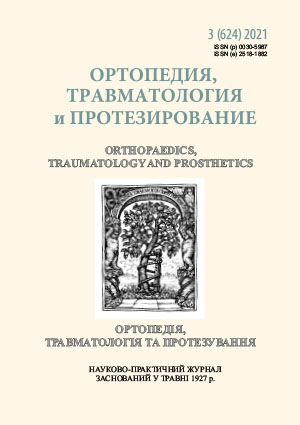ORTHOPEDIC MANIFESTATIONS OF CONGENITAL VASCULAR MALFORMATIONS OF THE LOWER EXTREMITIES
DOI:
https://doi.org/10.15674/0030-59872021349-53Keywords:
Сongenital vascular malformations, orthopedic manifestations, leg length discrepancyAbstract
The spectrum of orthopedic manifestations of congenital vascular malformations of lower limbs remains insufficiently studied. Objective. To analyze the results of examination of patients with orthopedic manifestations of congenital vascular malformations. Methods. 24 patients with various forms of congenital vascular malformations of the lower extremities were examined. Distribution of patients according to the Hamburg classification of vascular malformations: arteriovenous type — 14 patients; venous — 6; capillary — 2; capillaryvenous — 1; lymphatic — 1 patient. The diagnosis of orthopedic
pathology was performed on the basis of clinical examination, X-ray, ultrasound, X-ray densitometry. Results. All patients with congenital vascular malformations were diagnosed with orthopedic pathology: leg length discrepancy (75 %), secondary scoliotic deformity (16 %), knee flexion contracture 40° (8 %), flatfoot (12 %), equinus deformity of the foot (8 %), osteoporosis of the affected limb (16 %), areas of pathological reconstruction of the affected bone (lytic areas) (4 %), hip osteoarthritis of the affected limb (grade 2) (4 %). Leg length discrepancy was observed due to the elongation of the affected
limb — in 16 patients (67 %), shortening — in 2 (8 %). Leg length discrepancy was in the range of 0.5–6 cm. Elongation of the affected limb < 2 cm was noted in 5 patients (21 %), > 2 cm — in 11 patients (46 %); shortening of the affected limb < 2 cm was observed in one patient (4 %), > 2 cm — in one patient (4 %). Among the patients with leg length discrepancy, 61 % had combinations of several orthopedic manifestations of the disease. Conclusions. Patients with congenital vascular malformations have a wide range of orthopedic pathology, among them the leading is leg length discrepancy (75 %) due to elongation
(67 %) or shortening of the affected limb (8 %). Leg length discrepancy is most often observed in patients with arteriovenous type of vascular malformation (67 %), elongation of the lower limb > 2 cm (75 %) significantly predominating in this category. Among patients with a difference in the length of the lower limbs in 61 % of cases, there is a combination with other orthopedic manifestations of the disease. Systematization of orthopedic pathology and development lesions’ classification of the musculoskeletal system taking into account the forms of vascular malformation will improve the diagnosis
of the disease and improve the tactics of its orthopedic treatment.
References
- Chernukha, L. M., & Kashirova, E. V. (2015). Classification of congenital vascular malformations: a tribute to fashion trends or an urgent need? View of a vascular surgeon. Hirurgiya of a child's vik, (1–2), 6–17. [in Russian]
- Dan, V. N., & Sapelkin, C. B. (2008). Angiodysplasia (congenital vascular malformations). Moscow: Verdana. [in Russian]
- Lee, B. B., Laredo, J., Lee, T. S., Huh, S., & Neville, R. (2007). Terminology and classification of congenital vascular malformations. Phlebology, 22(6), 249-252. https://doi.org/10.1258/026835507782655236
- Lee, B. B., Laredo, J., Lee, S. J., Huh, S. H., Joe, J. H., & Neville, R. (2007). Congenital vascular malformations: General diagnostic principles. Phlebology: The Journal of Venous Disease, 22(6), 253-257. https://doi.org/10.1177/026835550702200605
- Mattassi, R., & Vaghi, M. (2007). Vascular bone syndrome – angio-osteodystrophy: Current concepts. Phlebology: The Journal of Venous Disease, 22(6), 287-290. https://doi.org/10.1177/026835550702200610
- Kim, Y., Lee, S., Kim, D., Do, Y., & Lee, B. (2006). Risk factors for leg length discrepancy in patients with congenital vascular malformation. Journal of Vascular Surgery, 44(3), 545-553. https://doi.org/10.1016/j.jvs.2006.05.035
- Breugem, C. C., Maas, M., Breugem, S. J., Schaap, G. R., & Van der Horst, C. M. (2003). Vascular malformations of the lower limb with osseous involvement. The Journal of Bone and Joint Surgery. British volume, 85-B(3), 399-405. https://doi.org/10.1302/0301-620x.85b3.13429
- Boyd, J. B., Mulliken, J. B., Kaban, L. B., Upton, J., & Murray, J. E. (1984). Skeletal changes associated with vascular malformations. Plastic and Reconstructive Surgery, 74(6), 789-795. https://doi.org/10.1097/00006534-198412000-00010
- Goidanich, I. F., & Campanacci, M. (1962). Vascular Hamartomata and infantile Angioectatic Osteohyperplasia of the extremities. The Journal of Bone & Joint Surgery, 44(5), 815-842. https://doi.org/10.2106/00004623-196244050-00001
- Gloviczki, P., Hollier, L. H., Telander, R. L., Kaufman, B., Bianco, A. J., & Stickler, G. B. (1983). Surgical implications of klippel-trenaunay syndrome. Annals of Surgery, 197(3), 353-362. https://doi.org/10.1097/00000658-198303000-00017
- Cohen, J., & Cashman, W. F. (1975). Hemihypertrophy of lower extremity associated with Multifocal Intraosseous Hemangioma. Clinical Orthopaedics and Related Research, 109, 155-165. https://doi.org/10.1097/00003086-197506000-00024
- Vitale, M. A., Choe, J. C., Sesko, A. M., Hyman, J. E., Lee, F. Y., Roye, D. P., & Vitale, M. G. (2006). The effect of limb length discrepancy on health-related quality of life: Is the ‘2 cm rule’ appropriate? Journal of Pediatric Orthopaedics B, 15(1), 1-5. https://doi.org/10.1097/01202412-200601000-00001
Downloads
How to Cite
Issue
Section
License

This work is licensed under a Creative Commons Attribution 4.0 International License.
The authors retain the right of authorship of their manuscript and pass the journal the right of the first publication of this article, which automatically become available from the date of publication under the terms of Creative Commons Attribution License, which allows others to freely distribute the published manuscript with mandatory linking to authors of the original research and the first publication of this one in this journal.
Authors have the right to enter into a separate supplemental agreement on the additional non-exclusive distribution of manuscript in the form in which it was published by the journal (i.e. to put work in electronic storage of an institution or publish as a part of the book) while maintaining the reference to the first publication of the manuscript in this journal.
The editorial policy of the journal allows authors and encourages manuscript accommodation online (i.e. in storage of an institution or on the personal websites) as before submission of the manuscript to the editorial office, and during its editorial processing because it contributes to productive scientific discussion and positively affects the efficiency and dynamics of the published manuscript citation (see The Effect of Open Access).














